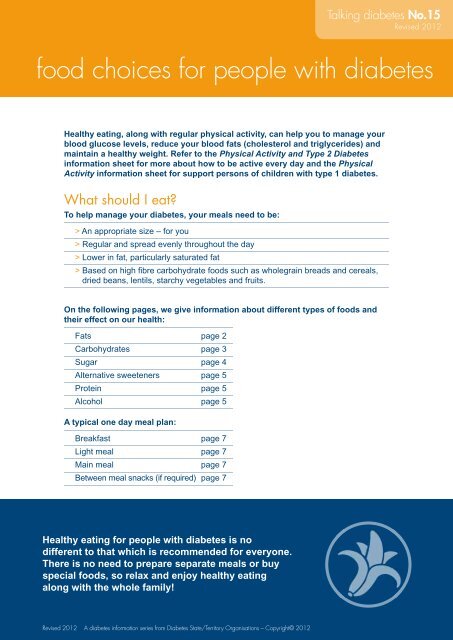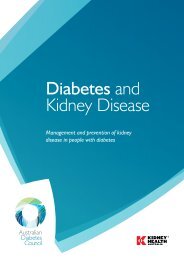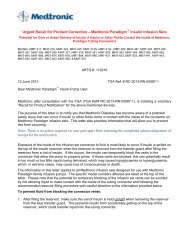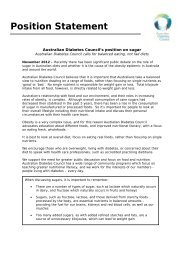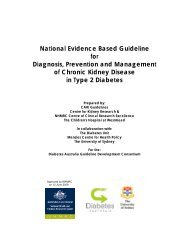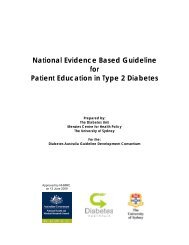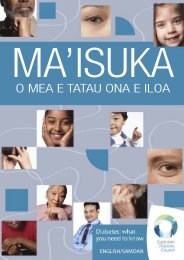food choices for people with diabetes - Australian Diabetes Council
food choices for people with diabetes - Australian Diabetes Council
food choices for people with diabetes - Australian Diabetes Council
Create successful ePaper yourself
Turn your PDF publications into a flip-book with our unique Google optimized e-Paper software.
Talking <strong>diabetes</strong> No.15Revised 2012<strong>food</strong> <strong>choices</strong> <strong>for</strong> <strong>people</strong> <strong>with</strong> <strong>diabetes</strong>Healthy eating, along <strong>with</strong> regular physical activity, can help you to manage yourblood glucose levels, reduce your blood fats (cholesterol and triglycerides) andmaintain a healthy weight. Refer to the Physical Activity and Type 2 <strong>Diabetes</strong>in<strong>for</strong>mation sheet <strong>for</strong> more about how to be active every day and the PhysicalActivity in<strong>for</strong>mation sheet <strong>for</strong> support persons of children <strong>with</strong> type 1 <strong>diabetes</strong>.What should I eat?To help manage your <strong>diabetes</strong>, your meals need to be:> An appropriate size – <strong>for</strong> you> Regular and spread evenly throughout the day> Lower in fat, particularly saturated fat> Based on high fi bre carbohydrate <strong>food</strong>s such as wholegrain breads and cereals,dried beans, lentils, starchy vegetables and fruits.On the following pages, we give in<strong>for</strong>mation about different types of <strong>food</strong>s andtheir effect on our health:Fats page 2Carbohydrates page 3Sugar page 4Alternative sweeteners page 5Protein page 5Alcohol page 5A typical one day meal plan:Breakfast page 7Light meal page 7Main meal page 7Between meal snacks (if required) page 7Healthy eating <strong>for</strong> <strong>people</strong> <strong>with</strong> <strong>diabetes</strong> is nodifferent to that which is recommended <strong>for</strong> everyone.There is no need to prepare separate meals or buyspecial <strong>food</strong>s, so relax and enjoy healthy eatingalong <strong>with</strong> the whole family!1Revised 2012 A <strong>diabetes</strong> in<strong>for</strong>mation series from <strong>Diabetes</strong> State/Territory Organisations – Copyright© 2012
<strong>food</strong> <strong>choices</strong>FatFats have the highest energy (kilojoule or calorie) content of all <strong>food</strong>s. The type of fatis important, as well as the amount. Eating a lot of fat or eating fat regularly may makeyou gain weight which in the long run may make it more diffi cult to manage your bloodglucose levels. On the other hand by using small amounts you can still add fl avour toyour <strong>food</strong>. If you choose healthy fats you may improve your health and reduce your riskof heart disease.Saturated fat and trans fatIt is important to limit saturated and trans fats because they raise your LDL-C (‘bad’cholesterol) levels and lower HDL--C (‘good’ cholesterol).Saturated fat is found in animal <strong>food</strong>s like fatty meat, milk, butter and cheese. Vegetablefats that are saturated include palm oil (found in solid cooking fats, snack <strong>food</strong>s orconvenience <strong>food</strong>s) and coconut products such as copha, coconut milk or cream.Trans fats occur naturally in small amounts in meat and dairy <strong>food</strong>s. They can also be<strong>for</strong>med as a by-product of the manufacturing process and can be found in <strong>food</strong>s such asmicrowaved popcorn, croissants, biscuits, pastries, doughnuts, hard margarines (usuallycooking margarines) and commercial deep fried <strong>food</strong>s.To reduce saturated and trans fats:> Choose reduced or low fat milk, yoghurt, ice cream and custard.> Choose lean meat and trim any fat off be<strong>for</strong>e cooking.> Buy skiness chicken of where possible remove the skin from chicken (wherepossible, be<strong>for</strong>e cooking).> Avoid using butter, lard, dripping, cream, sour cream, copha, coconut milk,coconut cream and hard cooking margarine.> Try reduced fat cheese varieties.> Limit pastries, cakes, puddings, chocolate and cream biscuits to special occasions.> Limit pre-packaged biscuits, savoury packet snacks, microwaved popcorn, cakesand doughnuts.> Limit the use of processed deli meats (devon/polony/fritz/luncheon meat, chickenloaf, salami etc) and sausages.> Avoid fried takeaway <strong>food</strong>s such as chips, fried chicken and battered fi sh. ChooseBBQ chicken (<strong>with</strong>out the skin) and grilled fi sh instead.> Avoid pies, sausage rolls and pasties.> Avoid creamy sauces or dressings. Choose sauces based on tomato or other lowfat ingredients and low fat dressings made from small amounts of polyunsaturatedor monounsaturated fats (eg: sunfl ower, grapeseed, olive or canola oils).> Limit creamy style soups.2eating too much fat may make you gain wmore diffi cult to manage y
Polyunsaturated and monounsaturated fatSome fat is important <strong>for</strong> good health. Use a variety of polyunsaturated andmonounsaturated types to achieve a good balance.Polyunsaturated fats include• Polyunsaturated margarines (check the label <strong>for</strong> the word ‘polyunsaturated’)• Sunfl ower, saffl ower, soybean, corn, cottonseed, grapeseed and sesame oils• The fat found in oily fi sh such as herring, mackerel, sardine, salmon and tunaMonounsaturated fats include• Canola and olive margarines• Canola and olive oil• AvocadoSeeds, nuts, nut spreads and peanut oil contain a combination of polyunsaturated andmonounsaturated fat.Ideas <strong>for</strong> enjoying healthy fats:> Stir-fry meat and vegetables in a little canola oil (or oil spray) <strong>with</strong> garlic or chilli> Dress a salad or steamed vegetables <strong>with</strong> a little olive oil and lemon juice or vinegar> Sprinkle sesame seeds on steamed vegetables> Use linseed bread and spread <strong>with</strong> a little canola margarine> Snack on a handful of unsalted nuts, or add some to a stir-fry or salad> Spread avocado on sandwiches and toast, or add to a salad> Eat more fi sh (twice a week) because it contains a special type of fat (omega 3)that is good <strong>for</strong> your heartCarbohydrateCarbohydrate <strong>food</strong>s are the best energy source <strong>for</strong> your body. When they are digestedthey break down to <strong>for</strong>m glucose in the bloodstream. If you eat regular meals andspread your carbohydrate <strong>food</strong>s evenly throughout the day, you will help maintain yourenergy levels <strong>with</strong>out causing large rises in your blood glucose levels.Between-meal snacks that contain carbohydrates can be useful <strong>for</strong> some <strong>people</strong> whotake insulin or <strong>diabetes</strong> tablets. Discuss <strong>with</strong> your accredited practising dietitian (APD)or credentialled <strong>diabetes</strong> educator to see if this applies to you.The amount of carbohydrate you eat will affect how high the blood glucose levels risein your bloodstream after a meal. Too large a serve can mean too large a rise.Although all carbohydrate <strong>food</strong>s break down into glucose, they do so at differentrates – some slow, some fast. The glycemic index (GI) is a way of describing how acarbohydrate-containing <strong>food</strong> affects blood glucose levels.3eight which in the long run may make itour blood glucose levels
<strong>food</strong> <strong>choices</strong>The best combination is to eat moderate amounts of carbohydrate and include highfi bre <strong>food</strong>s that also have a low GI. Your dietitian (APD) can give you an idea of howmuch you need to eat.The <strong>food</strong>s listed below are high in carbohydrate and are healthy <strong>choices</strong>. Thosein bold have a lower GI:> Bread or bread rolls – especially wholegrain and wholemeal varieties such asBurgen ® Breads, Tip-Top 9 Grain Original, 9 Grain Wholemeal®, 9 GrainOriginal Mini Loaf, Wonderwhite® Lower GI.> High fi bre breakfast cereals such as rolled oats, All-Bran ® , Guardian ® , Weet-Bix ®and untoasted muesli.> Pasta, rice (Basmati or Doongara) and other grains such as barley, bulgur,quinoa and couscous.> Legumes – baked beans, kidney beans, chick peas, lentils, 3 bean mix.> Fruit – all types such as apples, oranges, peaches, bananas, melons. Fruit is agood source of fi bre; try to eat the whole fruit rather than drinking the juice. Includeat least 2 serves of fruit a day (1 serve = 1 medium piece apple, orange or pearOR 2 small kiwifruit or plums).> Milk products or dairy alternatives – choose low fat varieties of milk, soy drink(calcium <strong>for</strong>tified), yoghurt and custard. Include 2–3 serves a day (1 serve = 1 cupof milk OR 200 g yoghurt).> Vegetables that contain a signifi cant amount of carbohydrate – potatoes, orangesweet potato, yams, sweet corn. Other vegetables (such as salad vegetables,green vegetables, and orange vegetables) are generally low in carbohydrate andthere<strong>for</strong>e have little effect on your blood glucose levels. Include at least 5 servesof vegetables each day (1 serve = 1 cup salad vegetables OR ½ cup cookedvegetables).> You also need to consider a <strong>food</strong>’s other nutritional qualities such as fat, addedsugar and salt content. While some high fat <strong>food</strong>s and many sugary <strong>food</strong>s such aschocolate, ice cream and toasted muesli have a low GI, they are often not suitable<strong>for</strong> everyday eating.> Some occasional <strong>food</strong>s (such as dry or sweet biscuits, chocolate or chips) andsugary <strong>food</strong>s (such as jam, honey or sugar) are also carbohydrate <strong>food</strong>s. Thesecan be eaten in small amounts.SugarA healthy eating plan <strong>for</strong> <strong>diabetes</strong> can include some sugar. However, it is still importantto consider the nutritional value and the quantity of the <strong>food</strong>s you eat. In particular,be aware of the amount of high sugar <strong>food</strong>s such as sweets, lollies and standard softdrinks that you eat.4the best combination is to eat modeinclude high fi bre <strong>food</strong>s t
Some sugar can be used in cooking and many recipes can be modifi ed to use lessthan the amount stated or substituted <strong>with</strong> an alternative sweetener. Select recipesthat are low in fat (particularly saturated fat) and contain some fi bre , <strong>for</strong> example a fruitbased dessert <strong>with</strong> a low-fat crumble topping.In general, be aware of the type and amount of sugars added to <strong>food</strong>s.(manufacturerssometimes use fruit juice or other sources of sugar to avoid using table sugar). If toomuch is eaten, they may affect your weight, dental health and overall <strong>diabetes</strong> control.Discuss <strong>with</strong> your dietitian or <strong>diabetes</strong> educator about when and how frequently toinclude these types of <strong>food</strong>s/drinks.Alternative sweetenersWhile it is no longer necessary to always use alternative sweeteners instead of sugar,artifi cially sweetened products are suitable alternatives <strong>for</strong> <strong>food</strong>s and drinks that arehigh in added sugars, such as cordials and soft drinks.Alternative sweeteners based on acesulphame K (950)*, aspartame (951)*, cyclamate(952)*, saccharin (954)*, sucralose (955)*, alitame (956)*, stevia (960)* or neotame(961)* are all suitable <strong>for</strong> <strong>people</strong> <strong>with</strong> <strong>diabetes</strong>. They don’t provide kilojoules, won’taffect blood glucose levels and are found in many low joule products. These have allbeen approved <strong>for</strong> use in Australia by Food Standards Australia New Zealand. Howeverit is important to remember that many <strong>food</strong>s that use alternative sweeteners (such assoft drinks) are not everyday <strong>food</strong>s so should still be consumed in small amounts.ProteinMost protein <strong>food</strong>s do not directly affect your blood glucose levels. They includelean meat, poultry <strong>with</strong>out the skin, sea<strong>food</strong>, eggs (not fried), unsalted nuts and soyproducts such as tofu and legumes (dried beans and lentils). Legumes are a goodsource of fi bre and should be included regularly. They are also a carbohydrate <strong>food</strong> sowill affect your blood glucose levels.Protein <strong>food</strong>s do provide important nutrients <strong>for</strong> good health. However most <strong>Australian</strong>salready eat enough protein and do not need to eat more.Other <strong>food</strong>s, condiments and drinksYou can use these <strong>food</strong>s to add flavour and variety to your meals:> Herbs, spices, garlic, chilli, lemon juice, vinegar and other seasonings> Products labelled ‘low joule’ eg: low joule/diet soft drinks> Water, soda water, plain mineral water, tea, coffee, herbal teaAlcoholIf you enjoy alcohol, it is generally acceptable to have two standard drinks a day*.* This number may appear on the ingredient list in place of the name.5rate amounts of carbohydrate andat also have a lower GI
<strong>food</strong> <strong>choices</strong>However, if you need to lose weight, you may need to limit your alcohol intake further.It’s best to drink alcohol <strong>with</strong> a meal or some carbohydrate-containing <strong>food</strong> and aim tohave alcohol free days.One standard drink is equal to:> 100 ml wine > 285 ml regular beer> 30 ml spirits > 60 ml <strong>for</strong>tifi ed wine> 425 ml low-alcohol beer (less than 3% alcohol)It is important to remember:> That all alcoholic drinks are high in kilojoules and can contribute to weight gain.> That low alcohol or ‘lite’ beers contain less alcohol than regular beers so astandard drink size is larger.> People <strong>with</strong> <strong>diabetes</strong> do not need to have diet or low carbohydrate beers. Thesebeers may be lower in carbohydrate but they are not necessarily lower in alcoholor kilojoules.> When mixing drinks use low joule/diet mixers such as diet cola, diet ginger ale,diet tonic water.> That drinking a lot of alcohol can increase the risk of hypoglycaemia if you aretaking insulin or certain <strong>diabetes</strong> tablets.> Some <strong>people</strong> may need to have less alcohol than generally recommended due totheir age, medication or the need to lose weight. Discuss alcohol <strong>with</strong> your doctoror dietitian and refer to the Alcohol and <strong>Diabetes</strong> in<strong>for</strong>mation sheet.Weight managementBeing overweight, especially around your waistline, makes it more diffi cult to manageyour <strong>diabetes</strong> and increases your risk of heart disease.If you are overweight a small weight loss (5–10% of body weight) can make a bigdifference to your health. Aim to lose weight gradually and set small achievable goals.Measuring your waistline is a great way of checking your progress rather than weighingyourself regularly. In general, if you are of Caucasian origin, women should aim <strong>for</strong>a waist circumference less than 80 cm and men should aim <strong>for</strong> less than 94 cm.Appropriate measurements <strong>for</strong> other ethnic groups can be checked <strong>with</strong> your doctor.6If you are carrying excess weight around the middle, try to lose some of it by:• Reducing your portion sizes and following a diet plan lower in kilojoules and totalfat (particularly saturated fat). A dietitian (APD) can help you <strong>with</strong> specifi c advice onadjusting your <strong>food</strong> intake to help <strong>with</strong> weight loss.• Doing regular physical activity such as walking, dancing, riding a bike or swimming.• Seeking advice from your doctor, dietitian (APD), <strong>diabetes</strong> educator (CDE) or State orTerritory <strong>Diabetes</strong> Organisation.* NHMRC, <strong>Australian</strong> Guidelines to Reduce Health Risks from Drinking Alcohol (2009).if you drink alcohol, it’s best to have it <strong>with</strong> a mea
An example of a typical meal plan <strong>for</strong> one dayChoose <strong>food</strong>s you like and which satisfy you and remember to include carbohydrate<strong>food</strong>s in each meal or snack to help manage your blood glucose levels. Carbohydratecontaining<strong>food</strong>s are highlighted in italics in the menu below.Breakfast – <strong>for</strong> example…• ¾ cup of high fi bre breakfast cereal <strong>with</strong> low fat milk OR• 2 slices of bread or toast, preferably wholegrain, wholemeal or high fi bre white <strong>with</strong>thinly spread margarine, peanut butter, jam, Vegemite ® or try <strong>with</strong> baked beans,grilled tomato, or sardines PLUS• 1 piece of fruit• Tea, coffee or water• Light meal – <strong>for</strong> example…• 1 sandwich made <strong>with</strong> 2 slices of bread, or 1 bread roll or 4 dry biscuits –preferably wholegrain or wholemeal – <strong>with</strong> thinly spread margarine or try <strong>with</strong>avocado or fat-free mayonnaise instead• Salad vegetables• A small serve of lean meat, skinless poultry, sea<strong>food</strong>, egg, fat reduced cheese or amore generous serve of legumes (such as beans or lentils)• 1 piece of fruit• Water, tea or coffeeMain meal – <strong>for</strong> example…• 1 bread roll or 2 slices of bread (preferably wholegrain or wholemeal) OR 1 cup ofcooked pasta or rice OR 2 medium potatoes or 1 cup sweet potato or corn• Other vegetables (include freely)• A small serve of lean meat, skinless poultry, sea<strong>food</strong>, egg, fat reduced cheese or amore generous serve of legumes (such as beans or lentils)• 1 piece of fruit OR small amount of low fat yoghurt or custard• Water, tea or coffeeYou can eat your main meal at lunch or dinner, whichever you prefer.Between-meal snacksPeople <strong>with</strong> <strong>diabetes</strong> on certain types of tablets or insulin may require one snackbetween each meal and <strong>for</strong> supper. However, most <strong>people</strong> aiming to control their bodyweight may not need a snack between every meal. To fi nd out what is best <strong>for</strong> you,discuss this <strong>with</strong> your dietitian or <strong>diabetes</strong> educator.Good snack ideas include 1 piece of fruit, 1 tub of low fat yoghurt, 1 cup of low fat milk,1 slice of wholegrain bread, 1 slice of fruit bread or 2 high fi bre crispbreads. See thein<strong>for</strong>mation sheet Healthy Snacks and <strong>Diabetes</strong> <strong>for</strong> more snack ideas.7l and try to include alcohol-free days each week
<strong>food</strong> <strong>choices</strong>Your State or Territory <strong>Diabetes</strong> Organisation recommends that everyone <strong>with</strong> <strong>diabetes</strong>visit a dietitian (APD) <strong>for</strong> personal advice.For more in<strong>for</strong>mationThe example menu plan on page 7 is a guide only. For more personalised in<strong>for</strong>mation,an accredited practising dietitian (APD) will help.To find an APD in your area, contact:• The Dietitians Association of Australia on 1800 812 942 or www.daa.asn.au• Your State or Territory <strong>Diabetes</strong> Organisation on 1300 136 588 or go to their websiteas listed below.• APDs are based in many local hospitals, <strong>diabetes</strong> centres and community healthcentres and are also listed in the telephone directory.Would you like to join Australia’s leading <strong>diabetes</strong> organisation?> Dietary services > Free magazines > Children’s services> Educational literature > Product discounts > Support groupsFor more in<strong>for</strong>mation phone 1300 136 588 or visit your State/Territory Organisation’s website:ACT www.<strong>diabetes</strong>-act.com.au NSW www.australian<strong>diabetes</strong>council.comNT www.healthylivingnt.org.au QLD www.<strong>diabetes</strong>queensland.org.auSA www.<strong>diabetes</strong>sa.com.au TAS www.<strong>diabetes</strong>tas.com.auVIC www.<strong>diabetes</strong>vic.org.au WA www.<strong>diabetes</strong>wa.com.auThe design, content and production of this <strong>diabetes</strong> in<strong>for</strong>mation sheet have been undertaken by:> ACT <strong>Diabetes</strong> ACT > NSW <strong>Australian</strong> <strong>Diabetes</strong> <strong>Council</strong>> NT Healthy Living NT > QLD <strong>Diabetes</strong> Australia – Queensland> SA <strong>Diabetes</strong> SA > TAS <strong>Diabetes</strong> Tasmania> VIC 8 <strong>Diabetes</strong> Australia – Vic > WA <strong>Diabetes</strong> WAThe original medical and educational content of this in<strong>for</strong>mation sheet has been reviewed bythe Health Care and Education Committee of <strong>Diabetes</strong> Australia Ltd. Photocopying this publicationin its original <strong>for</strong>m is permitted <strong>for</strong> educational purposes only. Reproduction in any other <strong>for</strong>mby third parties is prohibited. For any matters relating to this in<strong>for</strong>mation sheet, please contactNational Publications at dapubs@tpg.com.au or phone 02 9527 1951.Health professionals: For bulk copies of this resource, contact your <strong>Diabetes</strong> State/Territory Organisations as listed.Revised 2012 A <strong>diabetes</strong> in<strong>for</strong>mation series from <strong>Diabetes</strong> State/Territory Organisations – Copyright© 2012


